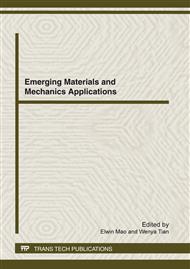[1]
Rubber Industry Report, 2007. International Rubber Study Group, January /February2007, p.1.
Google Scholar
[2]
Jana, G.K., Das, C.K., 2005a. Devulcanization of natural rubber vulcanizates by mechanochemical process. Polymer–Plastics Technology and Engineering 44, 1399–1412.
DOI: 10.1080/03602550500209853
Google Scholar
[3]
Jana, G.K., Das, C.K., 2005b. Devulcanization of automobile scrap tires by a mechanochemical process. Progress in Rubber, Plastics and Recycling Technology 21 (4), 319–331.
DOI: 10.1177/147776060502100405
Google Scholar
[4]
Zhang, X.X., Lu, C.H., Liang, M., 2007. Devulcanization of natural rubber vulcanizate, through solid state mechanochemical milling at ambient temperature. Plastics, Rubber and Composites 36 (7/8), 370–376.
DOI: 10.1179/174328907x237584
Google Scholar
[5]
Jana, G.K., Mahaling, R.N., Rath, T., Kozlowska, A., Kozlowski, M., Das, C.K., 2007. Mechanochemical recycling of sulfur cured natural rubber. Polymers 52 (2), 131–136.
DOI: 10.14314/polimery.2007.131
Google Scholar
[6]
Adhikari, B., De, D., Maiti, S., 2000. Reclamation and recycling of waste rubber. Progress in Polymer Science 25 (7), 909 - 948.
DOI: 10.1016/s0079-6700(00)00020-4
Google Scholar
[7]
Kohler R, O'Neill J. Rubber World 1977; 216(2): 32.
Google Scholar
[8]
Sekhar BC. European Patent Appliction EP 0690091 AL, (1995).
Google Scholar
[9]
Debapriya, D.E., Sukumar, M., Basudam, A., 1999. Reclaiming of rubber by a renewable resource material (RRM). II. Comparative evaluation of reclaiming process of NR vulcanizate by RRM and diallyl disulfide. Journal of Applied Polymer Science 73 (14), 2951–2958.
DOI: 10.1002/(sici)1097-4628(19990929)73:14<2951::aid-app19>3.0.co;2-b
Google Scholar
[10]
Debapriya, D.E., Sukumar, M., Basudam, A., 2000. Reclaiming of rubber by a renewable resource material (RRM). III. Evaluation of properties of NR Reclaim. Journal of Applied Polymer Science 75 (12), 1493–1502.
DOI: 10.1002/(sici)1097-4628(20000321)75:12<1493::aid-app8>3.0.co;2-u
Google Scholar
[11]
Debapriya, D.E., Amit, D.A.S., Debasish, D.E., 2006. Reclaiming of ground rubber tire (GRT) by a novel reclaiming agent. European Polymer Journal 42 (4), 917–927.
DOI: 10.1016/j.eurpolymj.2005.10.003
Google Scholar
[12]
Debapriya, D.E., Debasish, D.E., Singharoy, G.M., 2007. Reclaiming of ground rubber tire by a novel reclaiming agent. I. Virgin natural rubber/reclaimed GRT vulcanizates. Polymer Engineering and Science 47 (7), 1091–1100.
DOI: 10.1002/pen.20790
Google Scholar
[13]
Chuanwen C, Feng S, Yuguo L, Shuyun W. Orthogonal analysis for perovskite structure microwave dielectric ceramic thin films fabricated by the RF magnetron-sputtering method. J Mater Sci: Mater Electron 2009; 21: 349–54.
DOI: 10.1007/s10854-009-9919-y
Google Scholar
[14]
R.L. Arnold, C.P. Rader, Thermoplastic elastomer, in: M.J. Harper (Ed. ), Handbook of Plastics, Elastomers, and Composites, second ed., McGraw-Hill, (1992).
Google Scholar


